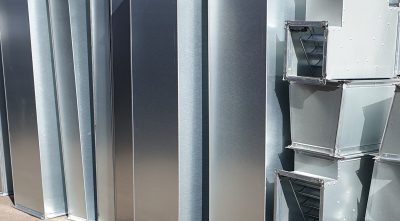The terms ‘rectangular ducting’ and ‘square ducting’ are often used interchangeably to mean the same thing. This article aims to clear up any confusion about square versus rectangular ducting & to answer many of the common questions that people ask about this type of ducting.
In the UK, most metal ducting is spiral ducting which is easier to manufacture, requires fewer materials & is much more efficient in terms of the volume of airflow that can be passed through it. Galvanised rectangular ductwork can be made to order but it is generally not as common or as useful as spiral ducting.
If you require galvanised rectangular ducting, we can make parts to order & so if this is something you require, please get in touch or take a look at our design service where we design & supply custom parts & can design & install them.
Is there a difference between rectangular and square ducting?
Technically speaking, no. You could argue that the shape of square ducting has to be a square whereas rectangular ductwork does not but it is commonly used by people to mean the same thing. When people commonly refer to square ducting it is because of the squared edges it has rather than the rounded edges of spiral ducting.
What is rectangular ductwork?
Rectangular ductwork is simply ducting that is squared or rectangular edges. It is not normally as common as spiral ducting because it’s not as efficient but it does have its uses. It is typically called into use where height restrictions or tight spaces won’t suit round ducting.
Why are rectangular ducts used?
Rectangular ducting is suitable for short, simple duct runs. It has the advantage of taking up less height than circular ducting (round ducting) so is often preferred when working with restricted or tighter space.
Plastic rectangular ducting is generally used in homes & commercial buildings where lower extraction rates are required than through regular circular ducting. They are used because they are easy to blend into environments like offices, bathrooms, toilets & utility rooms.
What are standard rectangular duct sizes?
The standard pvc rectangular ducting sizes are:
Standard diameters allow for easy fitting to ventilation equipment, ducting, grilles and extractor fans Plastic rectangular duct is sometimes called rectangular extractor ducting in relation to its being fitted to this extraction equipment.
Which is better, round or rectangular duct? Is round or square duct better?
Rectangular duct is not normally as common as standard round or spiral ducting for a couple of reasons: it takes 32% more material in order to make rectangular ducting than circular ducting & the airflow that a rectangular duct will sustain will be lower than the equivalent size of circular ducting. For any given diameter of ducting, the surface area of rectangular ducting is typically double the surface area of circular ducting.
The disadvantages of rectangular ductwork are:
- It takes 32% more material in order to make rectangular ducting than circular ducting & the airflow that a rectangular duct will sustain will be lower than the equivalent size of circular ducting
- For any given diameter of ducting, the surface area of rectangular ducting is typically double the surface area of circular ducting
- Spiral ducting generally requires 20% fewer supports over rectangular ducting & so there are extra material costs as well as extra labour costs for installation
- There is more friction created and thus less efficient airflow
- They allow more air & noise to escape from the duct
There are positives to rectangular ductwork, however. The advantages of rectangular ducting are:
- They can be made to order & made to fit where spiral ducting might not because of space restrictions
- It can look aesthetically pleasing where ductwork is exposed
- They can create warmer environments because of the increased surface area of the ducting
- They can often be shipped more easily
- They can be better for low pressure systems
Advantages of rectangular shapes are that they can be extruded easily. Plastic rectangular ducting is therefore easy to make & can be cost-effective & safe in applications where lower extraction rates are required (it installations in bathrooms & utility rooms).
How do you calculate CFM for a rectangular duct?
Airflow volume (in cubic feet per minute, CFM) is the measurement for airflow volume. The calculation for this is:
CFM = Flow Velocity (in feet per minute) x Duct Cross Sectional Area
The equation above is based on two elements, flow velocity & cross-sectional area.
Flow velocity is the square root of the velocity pressure.
In order to calculate cross-sectional area, a different equation is used for rectangular duct versus circular duct.
Round duct cross sectional area = π x r (radius of the duct in feet)²
Rectangular duct cross-sectional area = Height in feet x width in feet
So that’s how you do it. Calculating airflow volume for circular v rectangular ducts is very similar, you just have to be aware that cross-sectional area is calculated differently for round ducts than rectangular ones.
How do you insulate rectangular ductwork?
Thermal insulation is available for rectangular ductwork. This comes in the form of a sleeve for the relevant duct size that can be wrapped around rectangular ducting.
Ducting Express are ducting suppliers with expertise & stock in plastic rectangular ducting. We offer a range of stainless steel ducting & can even make bespoke rectangular ducting from stainless steel. Get in touch with us and let our trained and qualified experts answer all of your questions and help you make the right choice.
